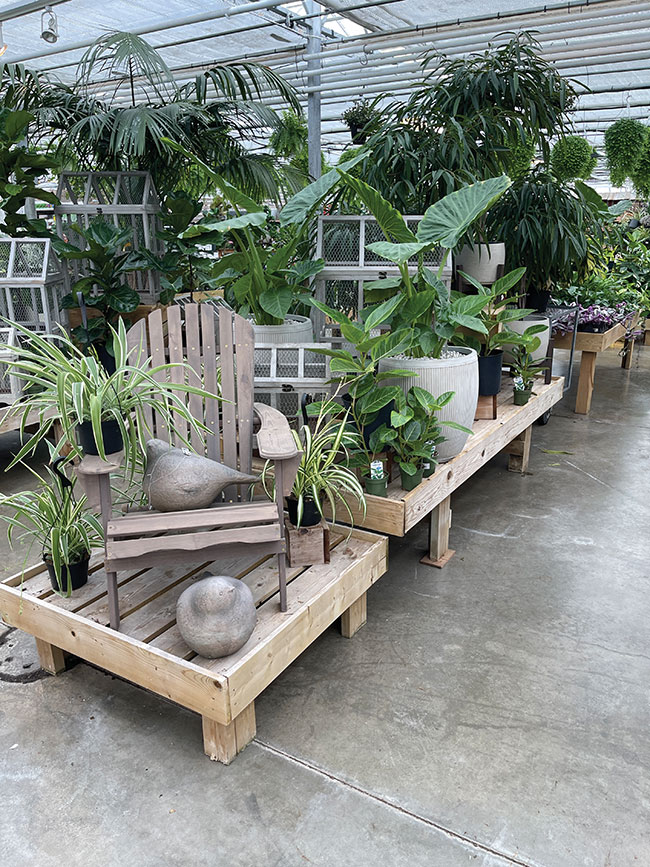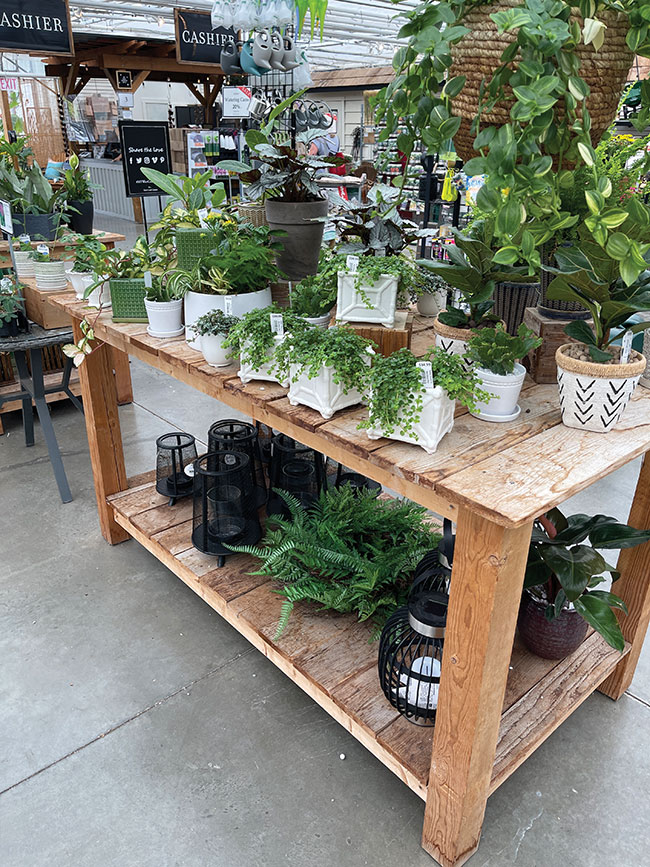
Features
Flowers
Retail
Trends
Hot for houseplants: Online communities and in-store displays
The lowly houseplant has reached new heights due to the availability of unusual species, the impact of online influencers and the pandemic.
November 2, 2021 By Treena Hein
 For West Coast Gardens, they’ve found that
simplicity can be best for their displays.
Photo credit: West Coast Gardens
For West Coast Gardens, they’ve found that
simplicity can be best for their displays.
Photo credit: West Coast Gardens Houseplants are feeling the love like never before. From the fiddle leaf fig to succulents, consumers are scooping them up at unprecedented rates.
“More recently, our customers have been people aged 30s to late 40s and they have really gravitated to the 4” to 6” tropicals,” notes Bryan Moffatt, retail operations manager at West Coast Gardens in Surrey, BC. “The plant sizes seem to be what they can fit into their homes. A lot of people wish that they could have larger tropicals but unfortunately they may not have the space.” Moffatt adds that plants with variegated leaves are always popular, along with plants having other unique leaf patterns, colours and shapes – Alocasias, for example.
Tropical plants with unique foliage are also in constant demand at The Watering Can, which has two locations near Niagara, Ont. “Our most popular are the succulents, fiddleleaf figs, snake plants, philodendrons and ZZ plants,” says Manager Sue Dodd. She adds that “any plant that has a variegation of white and green will remain in high demand as we enter 2022.”

The Watering Can changes up their displays to reflect current trends.
Photo credit: The Watering Can
There are a variety of reasons behind the booming desire for houseplants, notes Professor Bridget Behe at Michigan State University, who has conducted decades of research on garden centre retail trends. One clear reason is to allow a bit of the natural world into the living space. Another is for the fresh herbs and vegetables to use in cooking and baking. But Behe and her colleagues have found there are many more benefits – emotional ones.
“Some of the Millennials and many of the Gen Z in particular want to nurture something,” says Behe. “They may not yet have pets or human children, and being a ‘plant parent’ is a very rewarding experience. They enjoy caring for the plants, but from the research that we’ve done last year and this year, we’ve found there is a lot of emotional reward in the social connection benefits.”
In short, social media platforms are gathering places for much of the social interaction among new houseplant owners, allowing like-minded individuals to discuss their plants’ needs but mainly to take their plant enjoyment to the next level. By sharing stories and images with each other, houseplant owners derive a strong sense of belonging.
Behe also explains that many social media influencers have built interest in plants and are another focus for the ongoing social connection. She adds that there can be a vying for status in the community, and status can be attained if one can manage to acquire a rare or unusual plant that an influencer or someone in their social group already possesses. And in addition, “part of the fun,” says Behe, “can be the quest.”
Moffatt agrees that online plant groups seem to set the tone for ‘must-have’ plants. He adds, “Hoyas are very popular, but only certain types. When we brought in Hoya Sunrise, they sold out very quickly while Hoya Carnosa didn’t have the same draw. Plants seem to have their moment of fame and then, in a month, are not as desired anymore as the market is flooded.”
Overall, tropical plant supply at West Coast Gardens remains tight. “When plants do appear on availability lists, there are limits to the amount you can purchase,” Moffatt reports. “Unique items are not commonly found on availability lists. Many large growers will only sell to their larger purchasers, which makes it even harder to source unique plants.”
Behe confirms that huge demand from Millennials and GenZ in particular – who are very active on social media and are constantly on the lookout for new offerings – have led to sellouts over the past two years and contributed to some species being sold for exorbitant prices.
“As a result, we are also seeing some theft [at] retailers,” says Behe, “and in some cases, it’s the employees who are taking plants and selling them.”
Encourage demand
Aside from the need to perhaps boost their security, garden centres can benefit from the huge demand for houseplants if they are willing to put in the work.
Behe explains that smart retailers are developing a strong online presence to make themselves a hub for social network activity. “This will encourage sales,” she says, “but you need to watch the trends. Online platforms are always changing, and right now short videos are becoming more ‘in’ to compete with static photos. The social media interaction needs to be a consistent conversation, whether it’s about plant care or how to use herbs, and not a sales pitch. You want to keep people engaged and not turn them off.”
Retailers should also look at how they sell. “The pandemic has led to further development of the ‘culture of convenience’ and people are used to picking up pre-packaged groceries without having to visit the store,” says Behe. “Amazon is selling plants, plant pots and more. So, retailers should offer some conveniences, but of course they still have to make money. It’s great to give traditional classes if you have the space, but you can value-add in other ways. There are virtual ‘home’ classes or parties being offered where kits are picked up or delivered ahead of time, and people who know each other log on together or get together at one person’s home. But again, we have to make sure events are profitable.”
Rules for display
At West Coast Gardens, a few rules are followed in displaying house plants to ensure sales stay strong. One of them is simplicity. “Plants will truly shine when kept in a simple display,” says Moffatt. “We like to group our displays by type of plant, instead of having a variety found in multiple places. We also utilize height, ensuring our displays work from floor to ceiling. Too many items in a display will confuse a customer.” Moffatt adds that displays should have three colours at most, and that “colour blocking will draw the eye and allow dimension.”

Displays at West Coast Gardens have three colours at most and avoid overwhelming the customer with too much product at once.
Photo credit: West Coast Gardens
West Coast Gardens has found signage and themes to be very important. “We don’t want the customer to have any guess work in regards to questions they have,” says Moffatt. “Displays should also serve a purpose. Maybe they are highlighting low light plants, pet-friendly varieties or a specific plant family, such as Alocasias or Philodendrons.”
Lastly, displays at West Coast always have an inspirational angle to highlight the potential of a plant. “The goal,” says Moffatt, “is to help the person visualize the plant in their own space.”
Inspiration and connection are also a strong focus at The Watering Can, along with freshness. “All displays are an experience,” says Dodd. “Everything in that display area will provide the customer with the option to recreate a particular theme in their home. And as trends change, so do our displays.”
Print this page